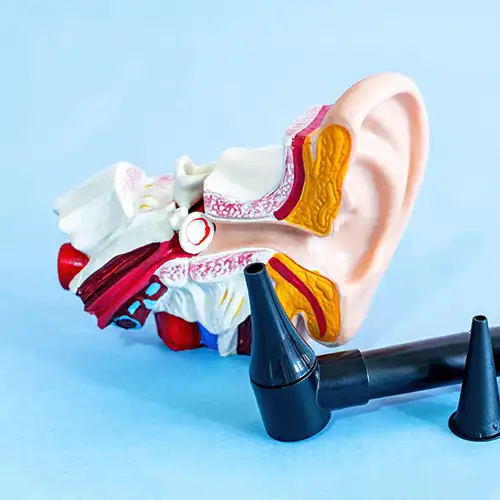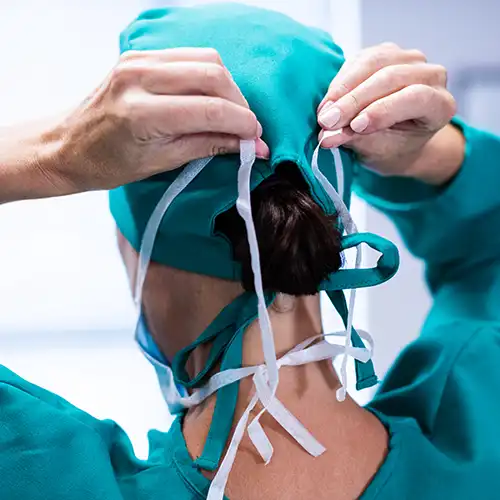A cholesteatoma is an abnormal, non-cancerous growth of skin cells that occurs in the middle ear, behind the eardrum. It usually develops as a result of recurring ear infections, poor Eustachian tube function, or a perforation in the eardrum.
Cholesteatomas can erode bones in the middle ear, leading to hearing loss and other complications if untreated.
There are two main types of cholesteatoma:
Cholesteatoma symptoms may include:
Treatment usually involves surgical removal to prevent further damage. If left untreated, cholesteatoma can grow and damage critical structures, including the hearing bones, inner ear, and facial nerve. In rare cases, it may lead to inflammation of the brain lining or brain infection.
Book in with a Cholesteatoma specialist at Complete ENT to discuss your treatment options.


Recurrent middle ear infections or repeated childhood ear infections can lead to the development of cholesteatoma. Chronic inflammation may cause the skin in the middle ear to grow abnormally, resulting in the formation of a cholesteatoma.
The Eustachian tube helps equalise pressure in the middle ear. If it becomes blocked or fails to function properly, negative pressure can develop, causing the eardrum to retract. This retraction can trap skin cells and lead to the formation of a cholesteatoma.
Grommets help by ventilating the middle ear, reducing this negative pressure, which might lower the risk of a retraction pocket forming and, consequently, cholesteatoma.
A perforation or hole in the eardrum can allow skin cells from the outer ear canal to enter the middle ear, leading to cholesteatoma formation.
Some individuals may be born with cholesteatoma, known as congenital cholesteatoma. This type can occur without a history of ear infections or eardrum perforation.
Injury to the ear, such as from an accident or surgical procedure, can create conditions conducive to the development of cholesteatoma.
Inadequate ear hygiene or neglecting ear infections can contribute to the formation of cholesteatoma.
Allergic reactions and chronic sinus problems may also lead to Eustachian tube dysfunction and contribute to the development of cholesteatoma.
Removal of the Cholesteatoma
The primary benefit is the complete removal of the cholesteatoma, which helps prevent further complications and damage to the ear structures.
Restoration of Hearing
While the primary goal is to remove the growth, the secondary goal wherever possible is to restore hearing. By addressing the damage to the eardrum and ossicles, cholesteatoma surgery can significantly improve hearing. Some patients experience a noticeable improvement in their hearing ability after the procedure.
Prevention of Complications
Cholesteatomas can lead to serious complications if left untreated, such as:
Cholesteatoma surgery helps reduce the risk of these serious complications.
Improved Quality of Life
Enhanced hearing and reduced risk of complications can lead to an overall better quality of life. Patients often experience less anxiety related to their ear health and can engage more fully in social and professional activities.
Management of Infections
Removing the cholesteatoma can help manage chronic ear infections, reducing the frequency and severity of future infections.

This is the most common type of cholesteatoma surgery. It involves removing the cholesteatoma and affected mastoid bone, which is the air-filled bone behind the ear.
The procedure can be:

Often done in conjunction with mastoidectomy, tympanoplasty involves repairing the eardrum (tympanic membrane) and the small bones involved in middle ear structures (ossicles) if they have been damaged. Endoscopic ear surgery techniques are often used to repair the eardrum.
The surgeon may use tissue grafts to reconstruct the ear drum and ossicles.
If the bones of the middle ear have been eroded by the cholesteatoma, this surgery reconstructs the ossicular chain to improve hearing. Prosthetic ear bones or the patient’s own tissue may be used.
 After the surgery, you will be monitored in the recovery room until the anaesthesia wears off. During this time, you may feel groggy or dizzy, which is normal. Pain management is an important part of the recovery process, as mild to moderate pain is common. Your doctor will prescribe pain relievers to help manage any discomfort, and it’s essential to follow the medication instructions carefully.
After the surgery, you will be monitored in the recovery room until the anaesthesia wears off. During this time, you may feel groggy or dizzy, which is normal. Pain management is an important part of the recovery process, as mild to moderate pain is common. Your doctor will prescribe pain relievers to help manage any discomfort, and it’s essential to follow the medication instructions carefully.
Some drainage from the ear may occur, which is expected, and you may have packing in the ear to absorb fluid and protect the surgical site.
Rest is crucial during the initial healing period. You should avoid strenuous activities and heavy lifting for several weeks to promote healing. Following your doctor’s instructions for ear care is essential, which may include keeping the affected ear dry and taking precautions during showers, such as using a shower cap.
Scheduling follow-up visits with your doctor is important to monitor healing and check for any signs of complications or cholesteatoma recurrence. Avoid blowing your nose or sneezing forcefully, as this can increase pressure in the ear and disrupt the healing process. Be on the lookout for signs of complications, such as increased pain, swelling, persistent or worsening discharge, fever, or sudden hearing loss. If you notice any of these symptoms, contact your healthcare provider as soon as possible.
The first few weeks after cholesteatoma surgery are critical for healing. You may experience fatigue, mild pain and some discomfort. Hearing may be initially impaired due to swelling and fluid in the ear, but many patients notice improvements within a few weeks as the healing process progresses. Complete recovery can take several weeks to months, depending on the extent of the surgery and individual healing factors. Your doctor will guide you on when to resume normal activities.
The recovery process varies for each person, but closely following your doctor’s instructions and attending all follow-up appointments will help ensure the best outcome.
After surgery, avoid swimming or submerging your head in water for several weeks. Gradually return to your regular activities as recommended, but avoid actions that could put pressure on your ears, such as flying, until cleared by your doctor. If you used hearing aids before surgery, consult with your doctor about when it’s safe to start using them again.
Our team of specialised ENT surgeons has extensive experience in diagnosing and managing ear conditions, ensuring precise surgical intervention. We provide comprehensive care, guiding patients from the initial evaluation through surgery and post-operative recovery.
With a patient-centred approach, we emphasise clear communication and personalised treatment plans. We also offer thorough follow-up care and access to a multidisciplinary team, ensuring all our patients’ needs are addressed during the healing process.


Call us on
07 3905 5999